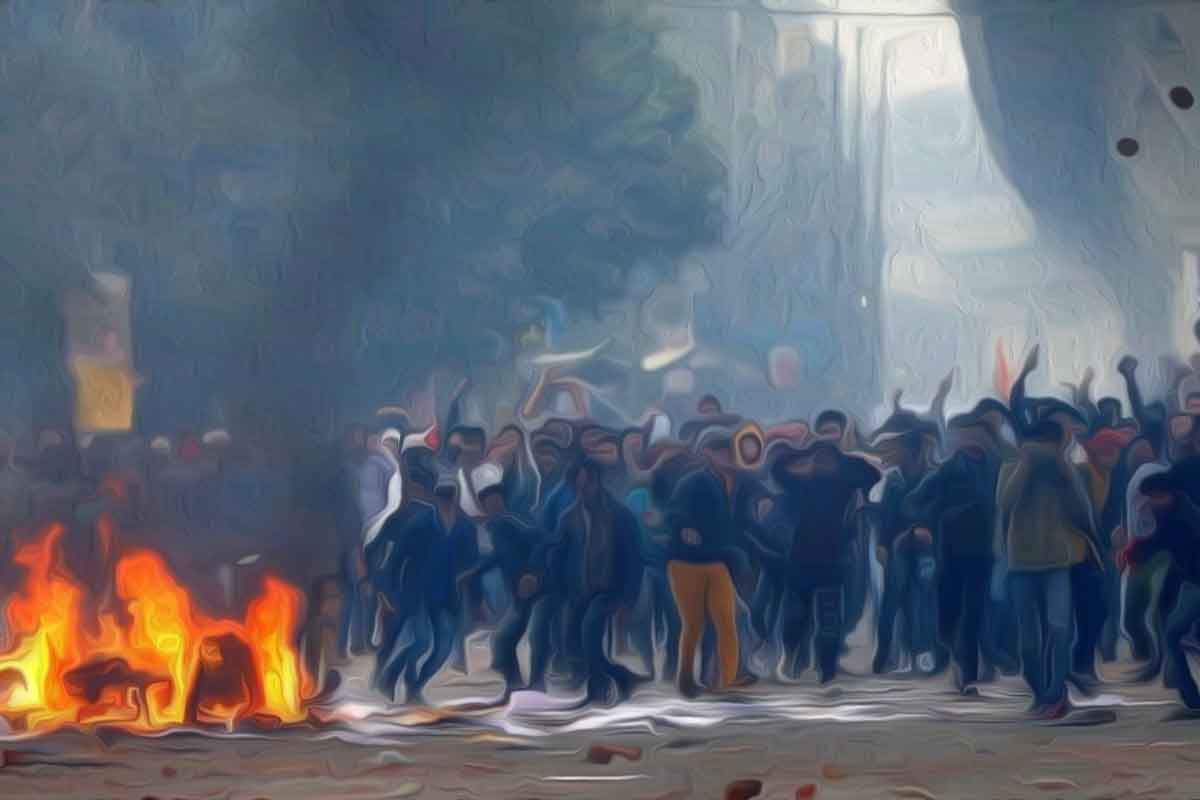More Coverage
Twitter Coverage
Satyaagrah
Written on
Satyaagrah
Written on
Satyaagrah
Written on
Satyaagrah
Written on
Satyaagrah
Written on
JOIN SATYAAGRAH SOCIAL MEDIA
No evidence to tie Dinesh Yadav to violence, intention assumed based on him being Hindu: Anti-Hindu riots by Muslim community that shook the capital city of India and analysis of the conviction

The Delhi anti-Hindu riots that shook the capital city of India, Delhi, just as the then USA President Donald Trump was visiting, was a stark reminder of just how fragile India’s internal security is, with bloodthirsty mobs, protected by a deeply entrenched ecosystem, looking for a reason to unleash violence against Hindus. The first murder during the violence that erupted on the 23rd of February with Muslim mobs running rampage was that of Ratan Lal. Soon after him, Dilbar Negi, a young daily wager, was brutally murdered. His hands and legs were chopped off before he was burnt to death.
With the cases in the Delhi Riots being heard in several Delhi Courts, the riots have again come under the scanner. Recently, a Delhi Court convicted one Dinesh Yadav in one of the riot cases. On the other hand, on January 18th, the Delhi High Court granted bail to six persons named Mohd Tahir, Shahrukh, Mohd Faizal, Mohd Shoaib, Rashid and Parvez in the Gokulpuri murder case related to the Delhi Riots of February 2020. The bail was granted by Justice Subramonium Prasad. The six were accused of vandalism and setting Anil Sweet Corner on fire “resulting in the death of 22-year-old Dilbar Negi”.
The conviction of Dinesh Yadav, coupled with the bail granted to the murderers of Dilbar Negi, expectedly, created flutters. While the Muslim organisations and the sympathisers of the rioters were rejoicing the conviction of a Hindu man, those who truly wanted to talk about the truth of the riots rued the inconsistencies in the two judgements passed days apart.
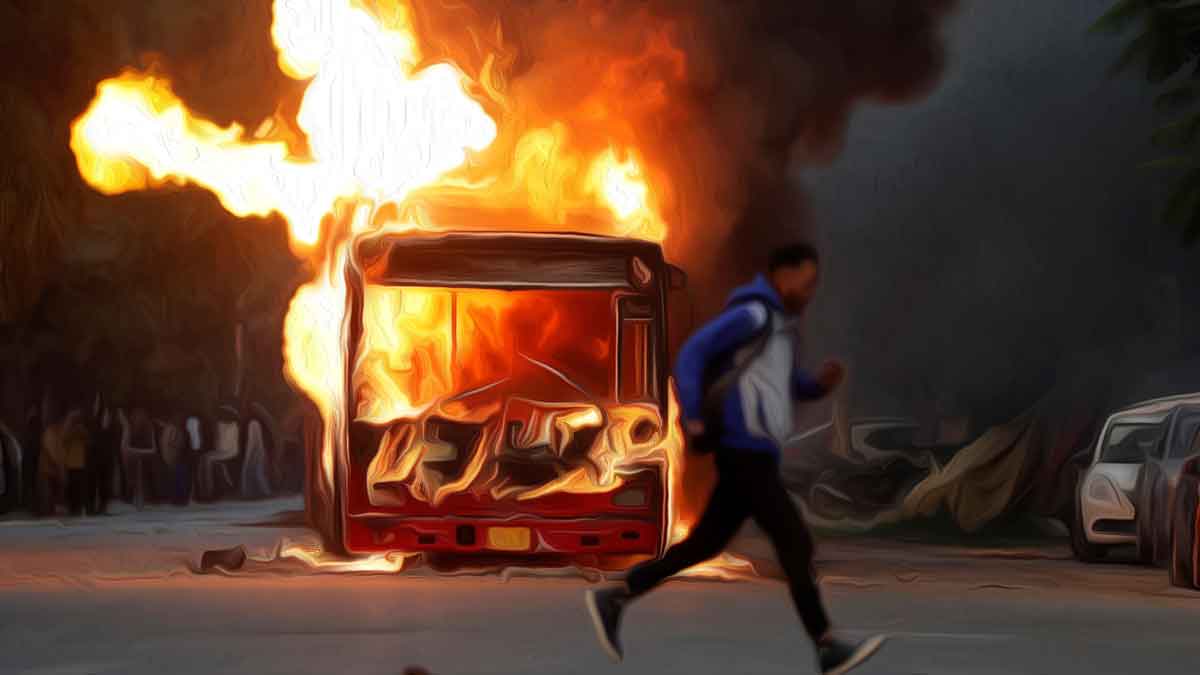 |
Indian American Muslim Council, that often spreads hate against Hindus and whitewashes the crimes of Muslims, took to Twitter to almost drum up a tweet of vindication. The international campaign to paint the Delhi anti-Hindu riots as an anti-Muslim pogrom was almost complete, per them. A Hindu man had been convicted and that gave wind to their theory that it was actually the Hindus who had conspired to murder the Muslims of Delhi.
|
The chargesheets filed in the Delhi Riots very clearly point towards a larger conspiracy that started to take shape as far back as 5th December 2019. The chronology of the violence makes it clear that the Muslim mobs, emboldened and well-funded, went on a rampage almost on a daily basis and per the conspiracy hatched, violence was unleashed on the 23rd of February against Hindus. However, that is now how the international propaganda played out and the conviction of Dinesh Yadav has widely been considered a vindication of that theory.
To understand why and how Dinesh Yadav was convicted and sentenced to 5 years in prison, the judgement by the court must be dissected.
The case in which Dinesh Yadav has been convicted pertains to a case of alleged violence from the 25th of February 2020 where a mob of Hindus had allegedly barged into the house of an old Muslim woman called Manori, stole and vandalised the house. According to the prosecutors, the woman had jumped to the adjacent building to save her life, along with a child, and was rescued by the police who had then escorted her to her relative’s house. An FIR in the case was registered on 3rd March 2020 and witnesses were examined.
The name of Dinesh Yadav had cropped up while the witnesses were being examined and he was named by not only the Muslim witnesses but also police officers who had given their eye witness testimony. On 03.08.2020, charges u/s 143/147/148/457/392/436/ 506 r/w section 149 IPC were framed against the accused to which he pleaded not guilty. Accordingly, a trial was held against him. 13 witnesses were examined. Dinesh Yadav had pleaded not guilty to all the charges and had said that he was being falsely implicated. It is pertinent to mention here that in a ground report by the media after the sentencing of Dinesh, the family had claimed that Dinesh was being falsely implicated because they had refused to pay bribes to the Delhi police officials falsely implicating him.
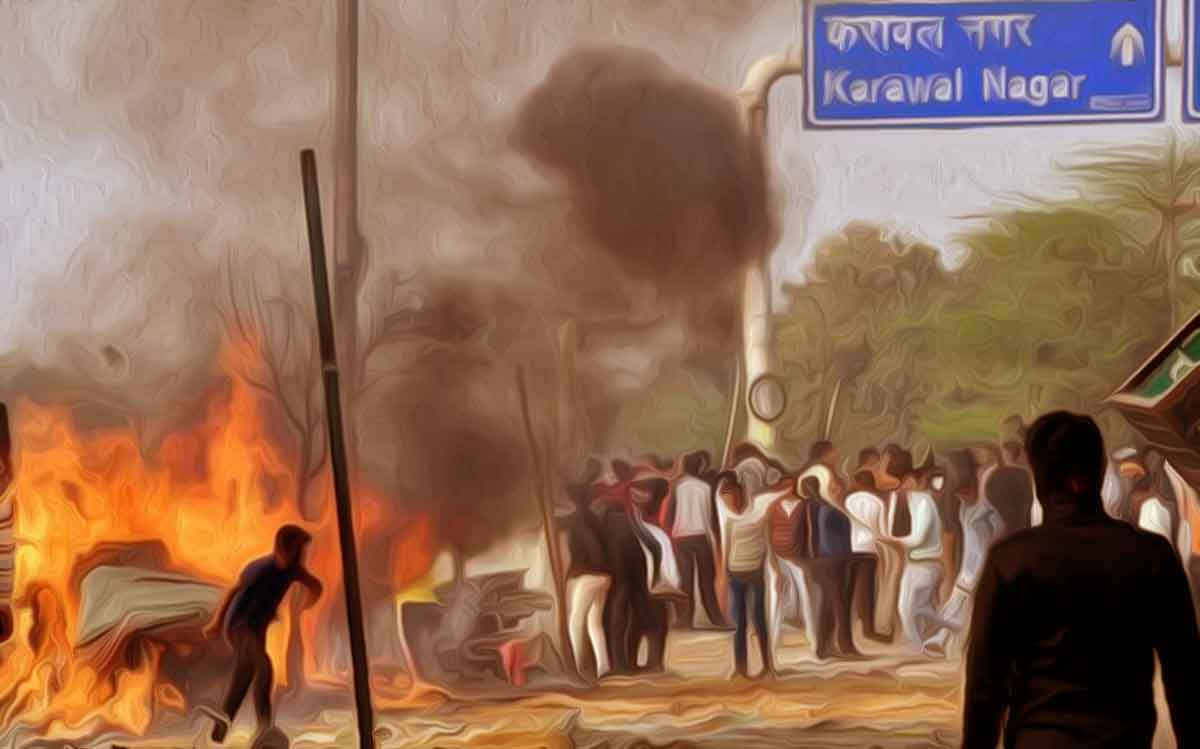 |
In the judgement, it is specifically mentioned that Dinesh had not provided any evidence to defend himself in the court of law.
Here is the first interesting aspect of the judgement convicting Dinesh.
In the judgement, it is clearly mentioned that Manori and her family members were not present in the house when the house was vandalised and burnt.
Manori, along with her family members and witnesses based on whose testimony Dinesh has been convicted, Ashiq and Arif, all denied telling the police that their house was vandalised in their presence and asserted that since they were not present in the house, they cannot identify any of the rioters. In fact, they were declared hostile by the public prosecutor during cross-examination because the prosecutor needed to disprove the assertion that they were not present in the house when the vandalisation took place.
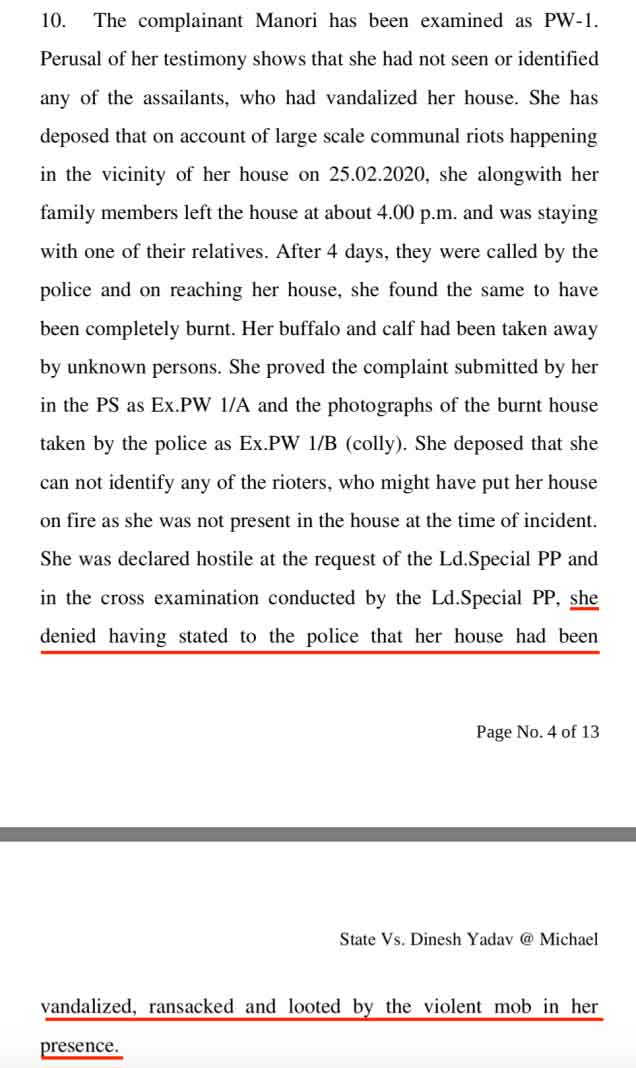 |
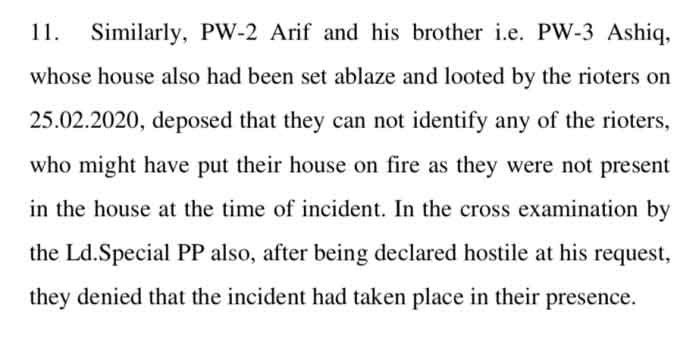 |
Just based on this, one can understand how the Muslim family has been changing their statement and making insinuations that don’t hold water. In an Indian Express report after the conviction of Dinesh Yadav, the statements of Manori, Ashiq and Asif almost sound as if they are saying they were present when the vandalisation took place but could not identify the rioters because they ran out in a hurry to save their lives. This is further evidenced by the fact that Manori tells Indian Express that she cannot identify the rioters because “they wore helmets”.
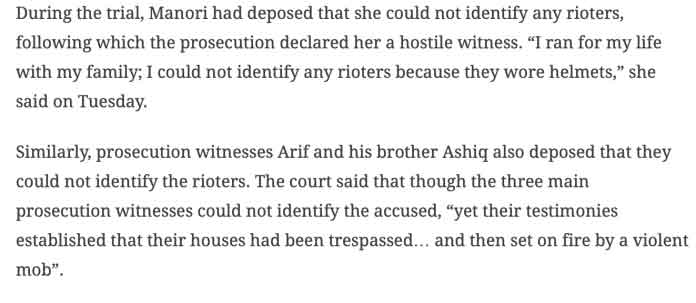 Indian Express report |
However, in the court document, it is evident that none of the family members was there when the vandalisation took place. So how can Manori now claim that they were wearing helmets and how did Indian Express not cross-question her while speaking to her?
The court, in its wisdom, said that even though none of the witnesses had identified the rioters, it was established by their statements that their house had indeed been vandalised.
The court examined two other key witnesses – Vipin and Sanoj – both police officers. One would think that these two had at least seen Dinesh giving a threat, entering the house, vandalising, setting fire or doing something illegal at the time. If not, at least that he was in possession of some incrementing material, the buffalo or the calf that was stolen from Manori’s house or any of the articles stolen to establish his role in the crime. That, however, is not the case.
The testimony of Vipin is that he saw the mob gathered at about 11 PM on 25th February (keep in mind that Manori said that they had left their house at 4 PM itself) and identified Dinesh as a part of the mob because he knew him from before, given that he is a beat officer in the area. However, in his testimony, he admitted that there is no incriminating evidence against Dinesh. He says that he and Sanoj, the other witness, were in the area on riot control duty.
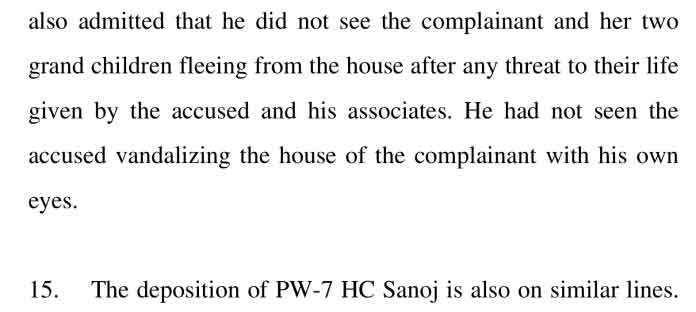 |
Let’s break this down.
Vipin and Sanoj, who were on riot control duty in the area, have deposed saying that they have zero evidence against Dinesh except the fact that they simply saw him in the area. He did not issue threats, he did not vandalise, he was not in possession of any danda or the buffalo stolen from Manori’s house – nothing. He was just there.
The lawyer defending Dinesh Yadav argued that the testimony of Vipin and Sanoj prove the innocence of Dinesh.
The judgement says:
It was vehemently argued by the Ld. Counsel for the accused that no active role has been attributed to the accused in the incident in question by these two witnesses which clearly indicates that the accused was only a bystander and did not share the object of the unlawful assembly. It is argued that the accused resides in the vicinity of the spot of incident and therefore, his presence on the road in the area during the riots was natural. According to the Ld. Counsel, the deposition of these two witnesses establishes the innocence of the accused and is liable to be acquitted.
 |
The court, in its judgement convicting Dinesh Yadav admits that there is no evidence to suggest that Dinesh Yadav was involved in vandalising the house. The court says:
It is true that the perusal of the testimony of PW6 and PW7, the two eyewitnesses to the incident in question, reveals that the accused had not taken any active part in vandalizing, looting or putting on fire the house of the complainant.
However, they say that from the testimony of Vipin and Sanoj, it is “clear” that he was a part of the mob that looted, vandalised and were identifying Muslims to beat them up. Further, it says that from the testimony of the complainant, it is clear that there was indeed large scale violence and the mob was carrying lathis, therefore, the mob was an illegal one.
To break this down, the court has admitted that from all the testimonies in front of it in the case, there was no proof that Dinesh Yadav was actually involved in the violence directly but the two police officers have claimed that they saw him in the area where the mob was, and therefore, he should be held liable.
The court has therefore based its judgement on section 149 and certain other judgements of the past.
The court said:
Once it is established that the unlawful assembly had some common object, it is not necessary that a person constituting unlawful assembly must be shown to have committed some overt act. For the purpose of incurring vicarious liability under Section 149 IPC, liability of the other members of the unlawful assembly for the offence committed during the continuance of the occurrence, rests upon the fact that whether the other members knew before hand that offence actually committed, was likely to be committed in prosecution of the common object. (see. Daya Kishan Vs. State of Haryana (2010) 5 SCC 81).
It further stated section 149 of the IPC.
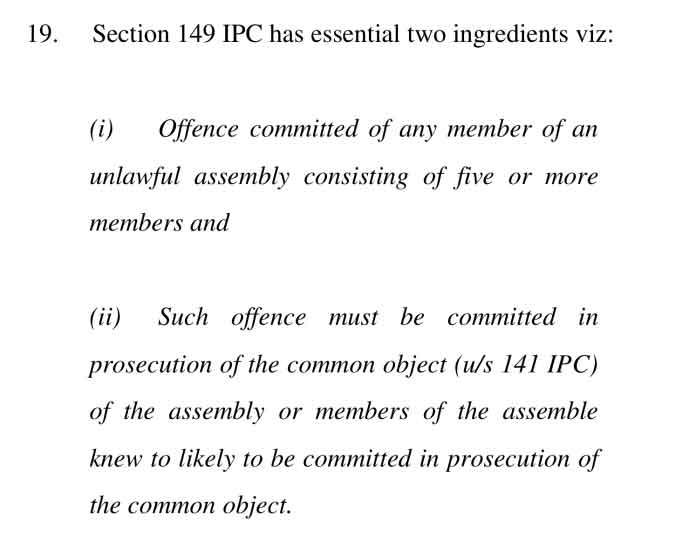 |
Essentially, the basis of the judgement convicting Dinesh Yadav was that he was seemingly a part of the mob and that he had prior knowledge that the common objective was to carry illegal activity and was a part of the mob nonetheless.
Interestingly, there is nothing in the judgement to prove that Dinesh had any knowledge of the crimes being committed or was a part of the mob per se. The police officers said they were carrying a danda but no such danda was recovered from Yadav. The lawyers had argued that he was simply in the vicinity because he lives in the same area and was a bystander.
The court has clearly “inferred” Dinesh Yadav’s motives and intentions without any direct evidence. It says that it is not impossible to collect information that proves what the motive of the individual was, but then goes on to say that the intention of the accused can be “inferred” from the circumstances.
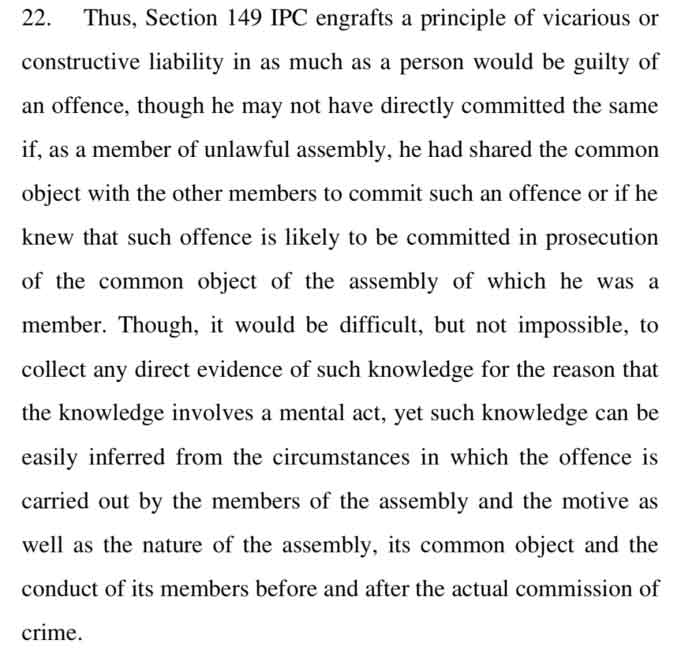 |
The obvious question to be asked here is how the court “inferred” that Dinesh Yadav shared the common objective of the mob. In the judgement, the court makes it clear that he is being assumed guilty because he is a Hindu.
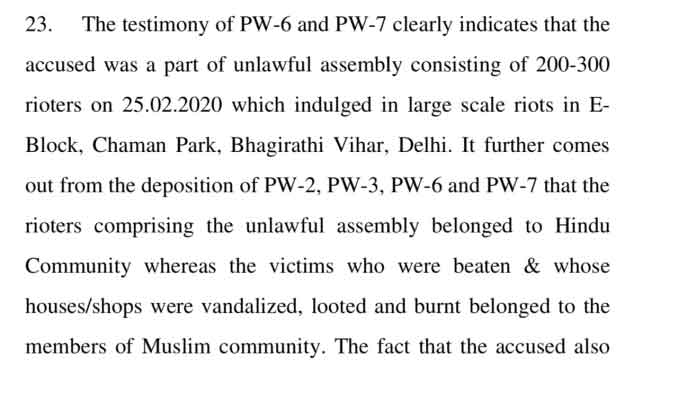 |
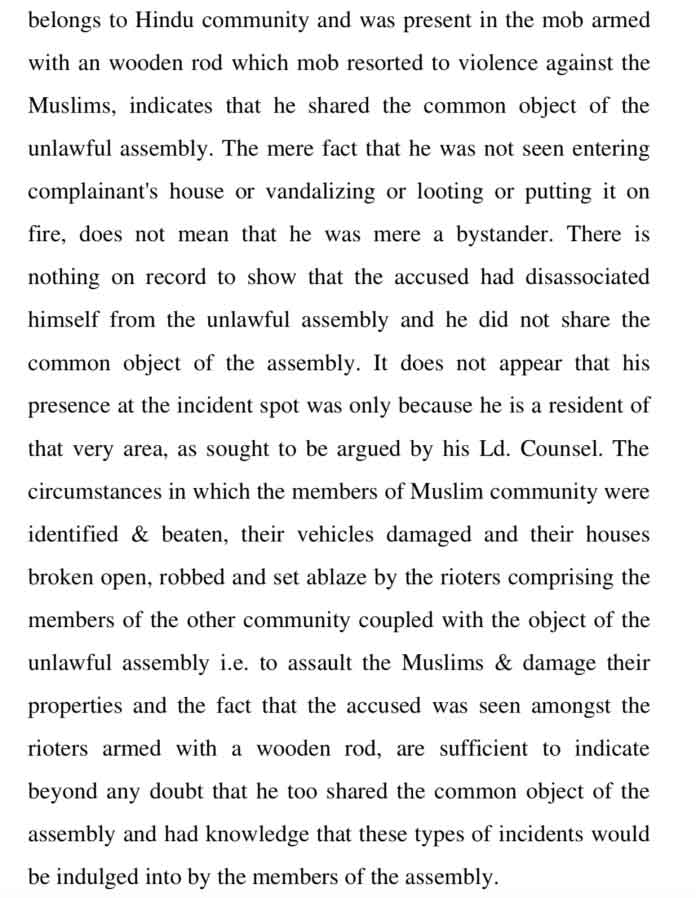 |
According to this, what has the court based the conviction on?
- The mob of rioters compromised of Hindus and Dinesh Yadav was also a Hindu, therefore, he must have shared the common objective of the mob.
- He was a part of the mob with a wooden rod and therefore he shared the common objective, however, the wooden rod was never recovered as the police officers testified.
- He did nothing to disassociate himself with the mob – nobody knows how the court reached this conclusion and how does one disassociate with a mob of 200 people. Further, who is supposed to testify that he did indeed try to disassociate or that he was a mere bystander.
- The court made a conjecture saying that it does not “appear” that he was merely a bystander.
- The court has convicted Dinesh Yadav because there is a testimony that he carried a wooden rod (which was never recovered) and because Muslims were singled out and their property was burnt by the crowd in the vicinity of which he was seen.

The court said:
Therefore, even though the evidence on record does not indicate that the accused had directly committed the offences involved in this case yet he is to be held guilty of all those offences which have been committed by the members of unlawful assembly for the reason that he shared the common object of other members of the assembly and knew that these offences are likely to be committed in prosecution of the common object of the assembly.
In the sentencing judgement, the court goes a step further and admits that the unlawful assembly was not a part of any conspiracy and that Dinesh has clean antecedents and was not involved in the violence at all.
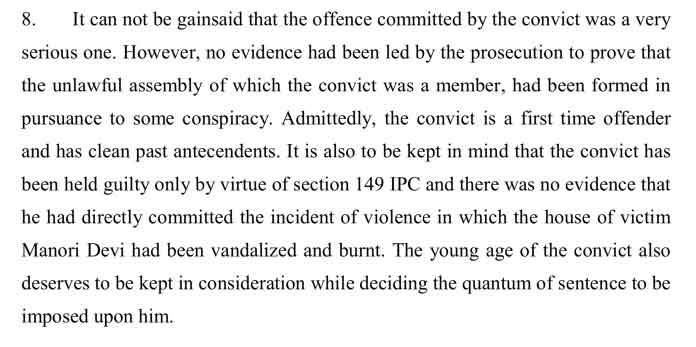 |
It is therefore evident that Dinesh Yadav has been convicted with paltry evidence against him, to serve a 5 year term for violence he did not commit. In fact, the most tragic part of the judgement is that guilt has been assumed on Dinesh’s part simply because he was a Hindu part of the mob that consisted of Hindu people, indulging in violence after the Muslim community had gone on a rampage unleashing violence against the Hindu community prior to this incident.
Interestingly, while giving bail to the accused in the Dilbar Negi murder case, the court had made very different observations with regards to 149 IPC based on which Dinesh Yadav has been convicted.
 |
Justice Subramonium Prasad, while granting bail to those accused in the Dilbar Negi murder case had said that the court needs to hesitate before arriving at the conclusion that every member of the unlawful assembly inhabits a common intention and that there cannot be umbrella assumption of guilty. This logic was extended to give bail to the accused in the Negi murder case, however, the same provisions were used, guilt assumed, to convict Dinesh Yadav.
It would not be a stretch of logic to say that the conviction of Dinesh Yadav appears to be a gross miscarriage of justice. In a ground report by the media, the family of Yadav had said that he was being framed because they had refused to bribe officials of the Delhi Police.
Dinesh’s mother said, “The Muslim woman who made the allegation was already having a fight with the Muslim people. Those people had already taken the buffalo away. All of them have accused the Hindus, just to save themselves. News spread in our area that Muslim people are coming here to kill. Then all the people of this colony had gathered. Everyone went there to stop those Muslims so that they should not come here. Nobody even came. My son also went to see the same. My son was told that this is a fight for the community. The people of the colony called it a fight for the community. Some of them ran away and some others stood back. The names of those who stood back were taken into the case. 22 people from my colony were named in this case.”
Budha Devi further added, “We did not take help from any relative. This fight was for the society. The people of this society are not getting up. What can you do now? The behavior of the policemen was very bad. They have done all this by taking bribe from others. 4-5 lakh rupees were being demanded from our family. From where do we poor people give so much money? We could not give money.”
Coupled with the allegations mounted by the family and the loop-hole ridden judgement that convicted and sentenced Dinesh Yadav, it becomes evident that a further probe is needed in the case that has now taken away 5 years off a young Hindu man’s life.
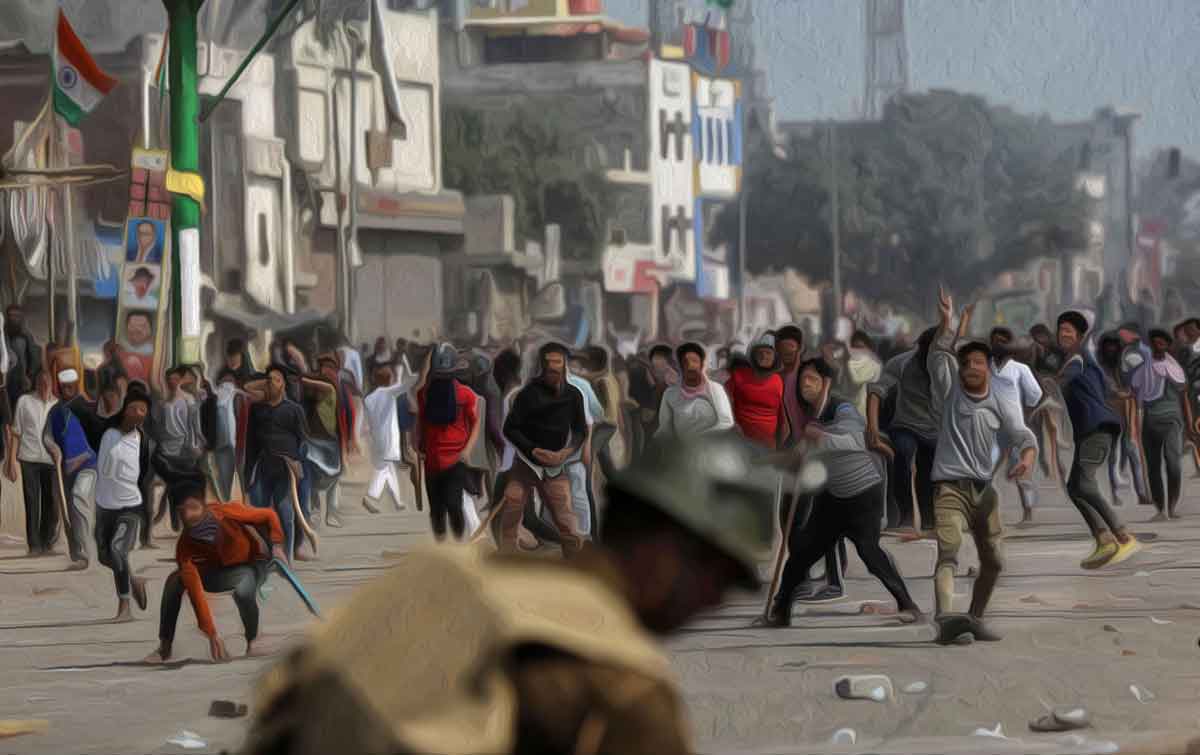 |
References:
 Support Us
Support Us
Satyagraha was born from the heart of our land, with an undying aim to unveil the true essence of Bharat. It seeks to illuminate the hidden tales of our valiant freedom fighters and the rich chronicles that haven't yet sung their complete melody in the mainstream.
While platforms like NDTV and 'The Wire' effortlessly garner funds under the banner of safeguarding democracy, we at Satyagraha walk a different path. Our strength and resonance come from you. In this journey to weave a stronger Bharat, every little contribution amplifies our voice. Let's come together, contribute as you can, and champion the true spirit of our nation.
 |  |  |
| ICICI Bank of Satyaagrah | Razorpay Bank of Satyaagrah | PayPal Bank of Satyaagrah - For International Payments |
If all above doesn't work, then try the LINK below:
Please share the article on other platforms
DISCLAIMER: The author is solely responsible for the views expressed in this article. The author carries the responsibility for citing and/or licensing of images utilized within the text. The website also frequently uses non-commercial images for representational purposes only in line with the article. We are not responsible for the authenticity of such images. If some images have a copyright issue, we request the person/entity to contact us at This email address is being protected from spambots. You need JavaScript enabled to view it. and we will take the necessary actions to resolve the issue.
Related Articles
- Haji Abdul Majeed and Rajab arrested for plotting to unleash violence during the ongoing Hijab protests by Muslim girl students outside Kundapura college, knives recovered: Karnataka
- 16 Jan to 22 Jan - 2022 - Continuing attacks on Hindus: bulletin roundup of persecution, discrimination, and hate crimes against Hindus
- Just a few months before the raging Hijab controversy, Muslim residents of Udupi had boycotted local fishermen for participating in a mega Padayatra to protest against illegal theft and slaughter of cows
- Girl students wear saffron shawls, chant Jai Shri Ram to protest against hijab in Karnataka: What Ambedkar meant about Women in Islamic Veil by saying, ‘One of the most hideous sights one can witness in India’
- Maulana Usmani says Muslims must continue to defend the honour of the Prophet without fear, terms it ‘peaceful mission’: Old videos show how Maulana was greeted with chants of ‘Sar Tan Se Juda’
- In another incident of ‘Land Jihad' how property in Shiv Shakti society of Mora, Surat, came in possession of Waqf Board: Gandhinagar based trust claims that Board is illegally taking over properties by misusing the Waqf Act, 1995
- Mohammedan needs to 'take back Babri Masjid', ISIS magazine states that Hindus are ‘filthy urine drinkers’ who learned civilized living from Muslims
- 'Anti-Hindu Delhi riot was remotely supervised by Umar Khalid just like 9/11 conspirators,’ prosecutors oppose Khalid’s bail plea, says 'Riot key conspirators were like entertainers who resorted to damrubaazi to attract crowd'
- To be on the wrong side of history is a choice – How 21st-century invaders are capturing Chhatrapati Shivaji’s forts the way even Mughals didn’t and attempting to reclaim an invader identity unapologetically
- While Shaheen Bagh showcases its latest artwork for anti-CAA 'protest', it also reveals its true nature of Islamist supremacy and Hinduphobia: Adds image of Hindu Swastika being ‘smashed’ and disintegrating
- Qatar-based Sheikh Eid Bin Mohammad Al Thani Charitable Association has been funding millions of dollars to organizations associated with the Wahhabi school of thought since 2008-2009: Earlier accused by the US also for assisting Al Qaeda
- An ancient Mata Tripur Sundari temple located in a remote forest area was burnt down in Kulgam: Jammu & Kashmir Police tries to downplay the event saying it was a minor fire caused by 'diyas/arti’
- Radical Mohammedans chopped off Dilbar Negi's limbs and burnt him alive, the Islamic mob torched properties of Hindus till 24th Feb night: Fresh charge sheet against 12 in Delhi riots
- More videos of Maulana Usmani has surfaced showing how he openly called for violence and said, ‘CDS Bipin Rawat’s death was Allah’s work, Muslims should be prepared to kill or die’
- Selective Case filed against Hindu Yati Narasimhanand, Sagar Sindhuraj and SIT constituted to investigate alleged hate speech at Haridwar Dharma Sansad















